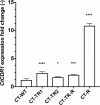Implications of the EUCAST Trailing Phenomenon in Candida tropicalis for the In Vivo Susceptibility in Invertebrate and Murine Models
- PMID: 30224538
- PMCID: PMC6256774
- DOI: 10.1128/AAC.01624-18
Implications of the EUCAST Trailing Phenomenon in Candida tropicalis for the In Vivo Susceptibility in Invertebrate and Murine Models
Abstract
Candida tropicalis isolates often display reduced but persistent growth (trailing) over a broad fluconazole concentration range during EUCAST susceptibility testing. Whereas weak trailing (<25% of the positive growth control) is common and found not to impair fluconazole efficacy, we investigated if more pronounced trailing impacted treatment efficacy. Fluconazole efficacy against two weakly (≤25% growth), two moderately (26% to 50% growth), and one heavily (>70% growth) trailing resistant isolate and one resistant (100% growth) isolate were investigated in vitro and in vivo (in a Galleria mellonella survival model and two nonlethal murine models). CDR1 expression levels and ERG11 sequences were characterized. The survival in fluconazole-treated G. mellonella was inversely correlated with the degree of trailing (71% to 9% survival in treatment groups). In mice, resistant and heavily trailing isolates responded poorly to fluconazole treatment. CDR1 expression was significantly higher in trailing and resistant isolates than in wild-type isolates (1.4-fold to 10-fold higher). All isolates exhibited ERG11 wild-type alleles. Heavily trailing isolates were less responsive to fluconazole in all in vivo models, indicating an impact on fluconazole efficacy. CDR1 upregulation may have contributed to the observed differences. Moderately trailing isolates responded less well to fluconazole in larvae only. This confirms clinical data suggesting fluconazole is effective against infections with such isolates in less severely ill patients and supports the current 50% growth endpoint for susceptibility testing. However, it is still unclear if the gradual loss of efficacy observed for moderately trailing isolates in the larva model may be a reason for concern in selected vulnerable patient populations.
Keywords: EUCAST; Galleria mellonella; azoles; fluconazole; in vivo; trailing.
Copyright © 2018 American Society for Microbiology.
Figures





References
-
- Arendrup MC, Dzajic E, Jensen RH, Johansen HK, Kjaldgaard P, Knudsen JD, Kristensen L, Leitz C, Lemming LE, Nielsen L, Olesen B, Rosenvinge FS, Røder BL, Schønheyder HC. 2013. Epidemiological changes with potential implication for antifungal prescription recommendations for fungaemia: data from a nationwide fungaemia surveillance programme. Clin Microbiol Infect 19:e343–e353. doi:10.1111/1469-0691.12212. - DOI - PubMed
-
- Tan TY, Hsu LY, Alejandria MM, Chaiwarith R, Chinniah T, Chayakulkeeree M, Choudhury S, Chen YH, Shin JH, Kiratisin P, Mendoza M, Prabhu K, Supparatpinyo K, Tan AL, Phan XT, Tran TTN, Nguyen GB, Doan MP, Huynh VA, Nguyen SMT, Tran TB, Van Pham H. 2016. Antifungal susceptibility of invasive Candida bloodstream isolates from the Asia-Pacific region. Med Myco 54:471–477. doi:10.1093/mmy/myv114. - DOI - PubMed
-
- Fernández-Ruiz M, Puig-Asensio M, Guinea J, Almirante B, Padilla B, Almela M, Díaz-Martín A, Rodríguez-Baño J, Cuenca-Estrella M, Aguado JM. 2015. Candida tropicalis bloodstream infection: incidence, risk factors and outcome in a population-based surveillance. J Infect 71:385–394. doi:10.1016/j.jinf.2015.05.009. - DOI - PubMed
Publication types
MeSH terms
Substances
LinkOut - more resources
Full Text Sources
Other Literature Sources
Medical

